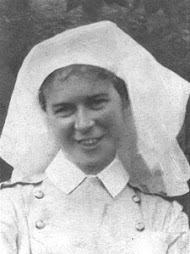It's the day after Remembrance Day. I spent part of yesterday in Edmonton at the only Ex-Service Women's Branch (#215)of the Royal Canadian Legion. A group of ex-service women were being presented with special medals in recognition of their service in the community. The women included veterans of the Second World War (as well as those who joined the service afterwards and served in various capacities across Canada and in Europe). It was wonderful to witness these often self-deprecating women being honoured by their families, peers, and some members of the current military. Surprisingly, I made another connection regarding the women and men of the First World War. I was seated next to a woman named Catharine Arthur, who had served as a wireless operator during the Second World War. "We lived war in our family," said Arthur. Her father had served in the trenches of the First World War and her aunt--Mary Elizabeth Miller--had been a nursing sister with the CAMC. (Miller was a nurse from Renfrew, Ontario. She trained in Michigan, moved to Edmonton, and enlisted in 1917. She worked at the Misercordia Hospital briefly after the war, then married and raised a family.) Catharine's father was gassed and died of the effects in 1929. Sadly, her family lost another family member in the Second World War--Catherine's only brother, shot down over Germany. So, today's blog is dedicated to Mary Millar and Catherine Arthur's father and brother.
Nursing Sister Christine Campbell
Today I'm profiling Nursing Sister Christina Campbell. Campbell was born in 1877 in Inverness, Scotland. Her family later moved to Victoria, British Columbia. Her attestation papers describe her at 5'7", with blue eyes and fair hair. She enlisted in London, England on September 16, 1915. Her papers were signed by the Matron in Chief of the CAMC, Margaret Macdonald. She served for two months in France, six weeks in Egypt and five months in Salonica. During her time in Salonica, she endured two months of night duty. According to the proceedings of a medical board, it was during this time that she became ill. She lost weight and suffered from headaches and pain in her back, shoulder blades and arms. Campbell was eventually "unable to sleep and in a very nervous condition, frequently crying when spoken to." She was told that she was suffering from neurasthenia and would be unfit for general service for at least three months. She was transferred to a convalescent hospital in England and later served in British military hospitals. Clearly, she was a hard-working, dedicated nurse. Sadly, her life would end while serving on the ill-fated hospital ship, the Llandovery Castle.
An excellent article has been written about Christina Campbell by writer Barbara Bavinton. It provides many interesting details about Campbell's early life and wartime service. I take the liberty here of quoting from that piece. To read the entire article, go to http://bcnursinghistory.ca.
"Christina Campbell left her native home in Inverness, Scotland and sailed to Victoria, British Columbia in 1893, when she was just 16 years old. Leaving her three sisters and parents, she travelled to the home of her brother Angus who owned a ladies wear shop on Broughton Street in Victoria. Four years later in 1897 she graduated from the Royal Jubilee Hospital School of Nursing as a graduate nurse.
In 1915 Christina was a member of the Army reservists when she enlisted in the Canadian Army Medical Corps (CAMC) as a Nursing Sister with the Canadian Over-Seas Expeditionary Force. She completed her army medical examination in Esquimalt, BC, the Matron-in Chief MacDonald signed her attestation papers and on September 6th. 1915 Christina arrived in London for four weeks of training before she was deployed.
Prior to the outbreak of the First World War there were just five permanent nurses in the CAMC and 57 in the reserves. By 1917 there were 2030 nurses with 1886 serving overseas. Nurses recruited for the Nursing Service were required to be single, in good health, and have a nursing diploma from a recognized school. They received 4 to 6 weeks of training at the Halifax Military Hospital followed by an oral and written exam. Priority was given to those nurses who, like Christina, already had some military training.
When Christina arrived in London she had her kit of blue dresses and white veils, her duty boots, cape, and a few personal belongings. She joined other Canadian “Bluebirds” as they awaited their assignments. The nursing sisters received C$50 per month in salary and an additional field allowance when away from home, and at that time were the only women in any armed forces to hold officer rank. Nursing Sister Christina Campbell had her pay assigned to the Bank of Montreal in London, had written her will, assigned David Miller as her executor, and bid her family goodbye. She was well prepared for active duty in the war effort.
She did not have to wait long as In October 1915 she was assigned to the #2 Canadian General Hospital (CGH) in France. A tent hospital of over 1,000 beds it had just been set up just 6 months before and had consistently coped with a heavy patient load since opening its doors. As many as 500 soldiers could arrive in a convoy and all had to be received, diagnosed, and allocated to wards with minimal delay. The work was relentless and the conditions challenging.
By mid November Christina was transferred back to London and then on to the #5 CGH of the medical evacuation force, where she worked ferrying the wounded to hospitals in England until June 1916, when she disembarked on the Duluce Castle to Salonica, Malta. This assignment was cut short when she became ill and was invalided back to England with neurasthenia and insomnia. After a year of active service and several months of continuous night duty and heat, Christina was ill and debilitated, so she was admitted to the Kings Cross Canadian Red Cross Convalescent Hospital in Bushey Park, London to regain her strength before returning to the #5 CGH and more medical evacuation work.
In August 1917 Christina was moved yet again to the Eye and Ear Hospital in Westcliffe in the UK, where she stayed until March 1918 when she was posted to transport duty on the Canadian hospital ship the Llandovery Castle. Hospital ship assignment was considered an easy posting and was often given as a reward to overworked nurses. The assignment entailed caring for the injured soldiers who were being shipped home to Halifax for convalescence, further medical attention, or medical discharge. On the return journey the Canadian doctors and nurses could enjoy the relaxing sea voyage under the hospital ship lights and designation, which by international agreement, protected them from enemy attack."
As Bavinton points out, these lights didn't ultimately protect the ship. For more on the Llandovery Castle, read earlier posts on this blog. I'll end my entry today with Bavinton's words:
"[Christina Campbell’s name is] inscribed on the Halifax Memorial in Nova Scotia’s capital. Standing in Point Pleasant Park, the 12 metre high Cross of Sacrifice is visible to all ships approaching the Halifax Harbour. It stands as a memorial to the over 3000 Canadian men and women who lost their lives at sea in the service of their country during the two world conflicts. “Their graves are unknown but their memory shall endure.”
Subscribe to:
Post Comments (Atom)






















No comments:
Post a Comment